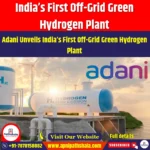India’s First Off-Grid Green Hydrogen Plant
General Studies Paper III: Environmental Pollution & Degradation, Growth & Development |
Why in News?
Recently India marked a major milestone by unveiling its first off-grid green hydrogen plant in Kutch, Gujarat. The plant makes clean hydrogen without relying on the main power grid. This achievement boosts India’s clean energy goals.
India’s First Off‑Grid Green Hydrogen Plant
- Location: The plant stands on a sun‑bathed site in Kutch district, Gujarat. The area is suitable because it receives strong sunlight and offers wide open land.
- Developed by: This project was built by Adani New Industries Limited (ANIL), part of Adani Enterprises’ green energy division.
- Core Features:
- The plant blends 5 megawatt solar PV capacity with a Battery Energy Storage System (BESS). This setup enables the facility to run completely off-grid.
- The heart of the plant lies in an automated closed‑loop electrolyser. It responds in real time to solar power fluctuations.
- This plant makes green hydrogen by using clean energy to break water molecules. The process emits no greenhouse gases.
- It aligns with India’s National Green Hydrogen Mission (launched in 2023).
- It demonstrates feasibility for off‑grid industries, especially in hard-to-abate sectors.
What Is Green Hydrogen and Why It Matters?
- Introduction:
- Green hydrogen is made from electricity that comes from renewable sources.
- Unlike conventional hydrogen, which is often made using fossil fuels, green hydrogen is created by electrolyzing water using electricity generated from solar, wind, or hydropower.
- This method separates hydrogen (H₂) from oxygen (O₂) in water, without releasing carbon dioxide or other harmful gases.
- An electrolyzer is the machine used to separate hydrogen and oxygen from water.
- Introduction:
- Importance:
- Green hydrogen addresses two urgent global problems: climate change and energy dependency.
- It produces zero emissions during production and use.
- It can power industries that are hard to decarbonize, such as steel, cement, aviation, and shipping.
- It reduces reliance on imported oil and gas, improving energy security.
- It helps countries meet their net-zero goals, such as India’s target to achieve net-zero emissions by 2070.
- Green hydrogen is not just about clean energy—it also brings economic benefits.
How the Off-Grid Model Works?
- Primary Energy Source: The off-grid hydrogen plant begins with solar energy. Large solar panels capture sunlight and convert it into electricity using photovoltaic (PV) technology. Solar farms generate electricity during daylight hours, and this forms the foundation of the hydrogen production process.
- According to the Ministry of New and Renewable Energy, India’s solar capacity crossed 80 GW in 2024, showing strong growth in clean power infrastructure.
- Battery Storage: Since solar panels only generate electricity during the day, the plant includes Battery Energy Storage Systems (BESS). These batteries store extra electricity generated during peak sunlight hours. The saved electricity helps run the electrolyzer during nighttime or cloudy conditions.
- By using advanced lithium-ion batteries or flow batteries, the plant ensures smooth operation 24/7.
- Electrolyzer: The next key component is the electrolyzer. Electricity helps divide water into two parts—hydrogen and oxygen. This process is called electrolysis. The electrolyzer receives energy either directly from solar panels or from stored battery power.
- Off-Grid Integration: The off-grid model does not depend on external power sources. All energy is generated on-site using solar panels. Batteries store any extra electricity. The electrolyzer uses this energy to produce hydrogen. No fossil fuels are burned, and no grid connection is needed. This closed-loop system reduces transmission losses.
India’s Green Hydrogen Vision
- India launched its bold green hydrogen agenda with the National Green Hydrogen Mission (NGHM) in January 2023.
- The NGHM began under the Ministry of New and Renewable Energy.
- The government set a goal of producing 5 million tonnes of green hydrogen per year by 2030, with potential to scale up to 10 million tonnes as export demand grows.
- A key target also includes supporting 125 GW of renewable capacity to power electrolyzers.
- The mission offers financial incentives through the SIGHT (Strategic Interventions for Green Hydrogen Transition) program.
- The government projects that green hydrogen costs could fall to around $1.37–$1.5/kg by 2030, down from over $4.50/kg today.
- The mission aims to stimulate local demand by mandating green hydrogen use in sectors like refineries, fertilisers, steel, and chemicals.
- The government plans to build 15 GW of electrolyzer capacity by 2030.
- A core objective of the NGHM is to make India a global export hub of green hydrogen and derivatives such as ammonia and methanol.
- The mission targets saving over US$11 billion of fuel imports by 2030 and cutting nearly 50 million tonnes of CO₂ per year.
- NGHM anticipates creating around 600,000 jobs by 2030 in manufacturing, R&D, and operations.
- The mission plans phases: initial pilots (2022–26), scale-up (2026–30), and export push after 2030.
Challenges to Scaling Up Green Hydrogen in India
- High Cost: One of the biggest hurdles India faces is the high cost of green hydrogen. In 2024, green hydrogen in India will cost about $4 to $5 per kilogram based on energy and tools used, while grey hydrogen made from fossil fuels stays under $2 per kilogram.
- Lack of Infrastructure: India’s current energy infrastructure is not ready to support widespread green hydrogen production and distribution. There is a shortage of electrolyzer manufacturing units and limited access to long-term storage solutions like underground hydrogen caverns.
- Global Competition: Several countries, including Germany, Japan, Australia, and the UAE, have already advanced in green hydrogen technologies and export planning. These nations offer strong financial incentives, established manufacturing bases.
- Policy Execution: Though the National Green Hydrogen Mission provides a strong vision, the actual policy execution varies across states. Clear rules for land acquisition, water use for electrolysis, and environmental safety are still evolving.
Solution for Scaling Up Green Hydrogen in India
- Manufacturing and Innovation: India must reduce its dependence on imported electrolyzers and green hydrogen equipment. At present, most advanced electrolyzers are sourced from the US, Europe, or China. This import reliance increases production costs and delays project timelines. A strong domestic manufacturing base will not only cut costs but also ensure timely supply.
- Infrastructure and Logistics: India currently lacks a national hydrogen transport and distribution network. The government must create a Green Hydrogen Infrastructure Corridor connecting production hubs like Gujarat, Rajasthan, and Andhra Pradesh to industrial consumption zones.
Global Partnerships: India must engage in strategic partnerships with global players for both technology transfer and market development. Several countries like Germany, Japan, South Korea, and the UAE are looking to import green hydrogen and ammonia. India has already signed initial hydrogen cooperation agreements with Germany (2022) and the European Union (2023).









